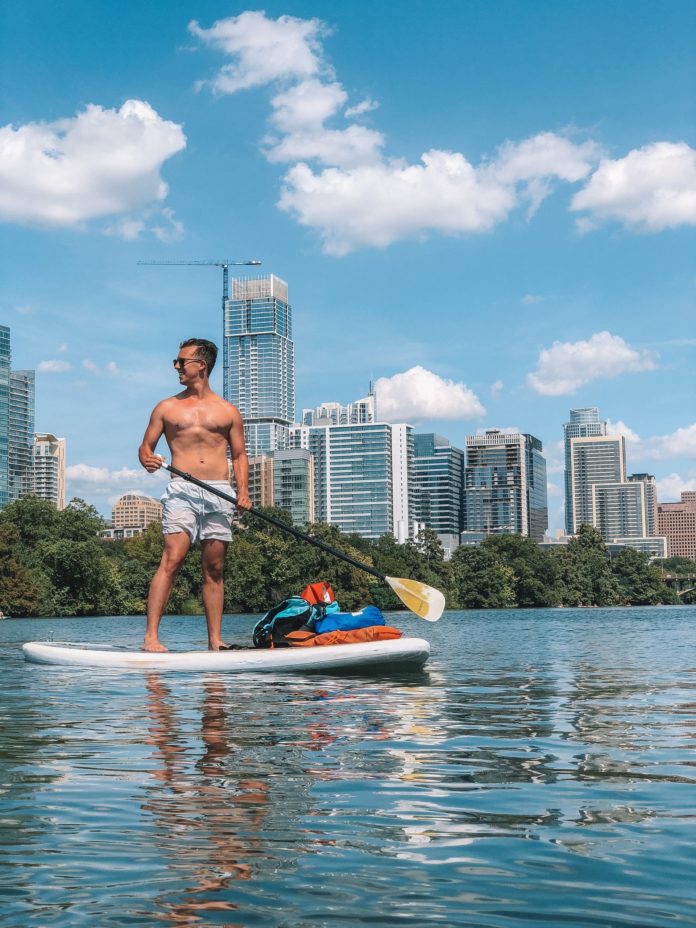Want to try one of the most exciting sports in the world right now? Why wouldn’t you. Stand up paddle boarding’s popularity is increasing all the time. It’s fun, it’s a great workout, and it has lots of mental health benefits too – a true stress reliever. However, there are a few things you need to think about before you take to the water. But don’t worry, this list will help you.
In this post, we’ll advise on some of the essentials you need for stand up paddle boarding. We’ll not only look at the equipment you need for the sport itself, but some other useful things to have too. Let’s check them out!
Essential Equipment
Stand up Paddle Board
Seems obvious, but to SUP you need a board. It’s not quite as simple as just finding a board and running to the ocean though – you need to find the right one for you and how you intend to use it. If you’re a beginner, you may want to try and all around SUP or an inflatable SUP.
For those who have been paddling for a while, you may want something more specialised, such as a touring paddle board, or a purpose-built paddle board for yoga or fishing.
Size matters too… You’ll need to get one that reflects your skill level and can support your weight. Beginners should choose a wider paddle board to aid balance.
Paddle
Once you’ve chosen your board, the next choice you must make is what paddle is right for you. Height adjustable paddles are quite versatile, and can be used for all types of SUP – from surfing to touring. The general rule is that a paddle should be 6 – 8 inches taller than you when stood beside you (unless you’re surfing, then it should be shorter).
If you’re buying (or renting) a paddle built for speed, take a look at fiberglass or carbon fiber options.
PFD
PFD stands for personal floatation device. In some destinations (such as Hong Kong), these are a legal requirement. In most other places, they’re an essential and handy piece of kit. A PFD is integral for safety – it will keep you afloat should you fall into the water. Even if you’re a super confident swimmer or are in shallow waters, it’s important to where your PFD, just to get into the habit.
Leash
The last essential piece of equipment for paddlers is the leash. Attached to your ankle, it will keep you tethered to your board should you fall off at any point. Don’t think that you can transfer SUP leashes and surf leashes by the way – SUP leashes are longer and thicker to cope with the weight of your SUP.
Essential Extras
Clothing
Of course, by clothing, we mean a swimsuit. In hot weather, at least. Usually, it is enough to have a pair of board shorts or a bikini/one piece swimsuit – whatever you feel more comfortable in. To protect yourself from the sun, you may also consider a swimshirt and/or rash guard.
However, there are some instances where that will not be enough. If you are paddling somewhere like the canals of Amsterdam or in Canada’s national parks, you’re likely to need a wetsuit. The 4-6 mm of neoprene will protect you against the cool waters, which are often even cooler than the air temperature.
In the coldest SUP destinations, such as Glacier Bay in Alaska, you’ll need a drysuit. This is likely to prevent you from going into shock should you fall into waters where the temperature is less than 7 degrees. Despite offering protection from the elements, dry suits won’t keep you warm. So layer up!
Sunscreen
If you paddle regularly, you’ll be exposed to the sun more than most people. While this is good for your vitamin D intake, if you don’t properly protect yourself, it can lead to major health problems. Avoid them by getting strong sunscreen. Choose a sunscreen that is right for your skin and re-apply it throughout your SUP sessions.
If possible, it’s always best to get reef-safe sunscreen. Not only will it protect your skin, but the environment around you too.
Water
If you go running, to the gym, or play soccer, the chances are you’ll make time for Water breaks. SUP is a sport and should be treated no differently. It’s extremely important to remain hydrated as you’re paddle boarding, so be sure to pack a reusable water bottle for your adventures. As well as keeping your thirst quenched, it’s better for the environment than plastic bottles!
Nice to have
Microfibre Towel
A microfibre towel is an essential piece of kit for anyone who does water Adventures sports, or even just enjoys a day out at the beach. These clever pieces of kit don’t work like normal beach or bath towels – after you use them, they’re instantly dry too!
As well as that, you can fold them up into the smallest spaces – perfect if you’ve got limited space in your backpack or duffel bag.
Dry Bag
A dry bag is an excellent thing to have if you’re planning a long SUP trip, or even just travelling from point to point. Rather than taking a regular backpack and worrying about getting your belongings wet, use a drybag instead. It’s watertight when closed properly, meaning that you can bring phones, cameras, money without them getting damaged.
Waterproof phone case
Last of all is a waterproof phone case. If you pack light and don’t need the use of a dry bag, you should at least consider a waterproof phone case. This will hang around your neck and keep your phone safe from the elements. After all, why wouldn’t you take photos to relive your trip later on, or impress your followers on Insta?!











